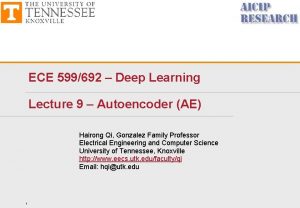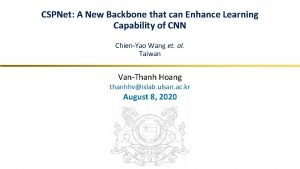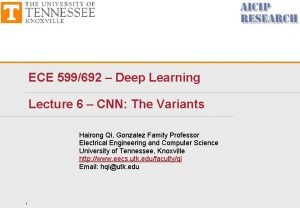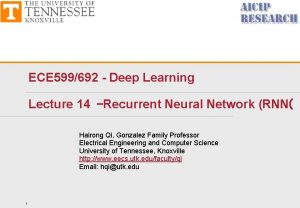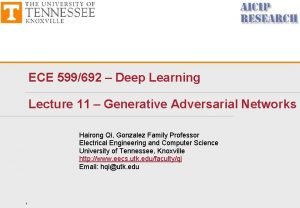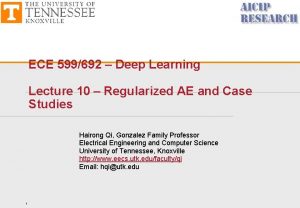ECE 599692 Deep Learning Lecture 5 CNN The








- Slides: 8

ECE 599/692 – Deep Learning Lecture 5 – CNN: The Representative Power Hairong Qi, Gonzalez Family Professor Electrical Engineering and Computer Science University of Tennessee, Knoxville http: //www. eecs. utk. edu/faculty/qi Email: hqi@utk. edu 1

Outline • Lecture 3: Core ideas of CNN – – Receptive field Pooling Shared weight Derivation of BP in CNN • Lecture 4: Practical issues – The learning slowdown problem – – – Quadratic cost function Cross-entropy + sigmoid Log-likelihood + softmax – Overfitting and regularization – – – L 2 vs. L 1 normalization Dropout Artificial expanding the training set – Weight initialization – How to choose hyper-parameters – – Learning rate, early stopping, learning schedule, regularization parameter, mini-batch size, Grid search – Others – Momentum-based GD • Lecture 5: The representative power of NN • Lecture 6: Variants of CNN – From Le. Net to Alex. Net to Google. Net to VGG to Res. Net • Lecture 7: Implementation • Lecture 8: Applications of CNN 2

The universality theorem • Neural networks with a single hidden layer can be used to approximate any continuous functions to any desired precision 3

Visual proof • One input and one hidden layer – Weight selection (first layer) and the step function – Bias selection and the location of the step function – Weight selection (2 nd layer) and the rectangular function (”bump”) • Two inputs and two hidden layers – From “bump” to “tower” • Accumulating the ”bumps” or “towers” 4

Beyond sigmoid neuron • The activation function needs to be well defined as z goes to both positive and negative infinity • What about Re. LU? • What about linear neuron? 5

Why deep network? • If two hidden layers can compute any function, why multiple layers or deep networks? • Shallow networks require exponentially more elements to compute than do deep networks 6

Why are deep networks hard to train? • The unstable gradient problem – Gradient vanishing – Gradient exploding 7

Acknowledgement • All figures from this presentation are based on Nielsen’s NN book, Chapters 4 and 5. 8
 Autoencoder
Autoencoder Cmu machine learning
Cmu machine learning Tony wagner's seven survival skills
Tony wagner's seven survival skills A new backbone that can enhance learning capability of cnn
A new backbone that can enhance learning capability of cnn 01:640:244 lecture notes - lecture 15: plat, idah, farad
01:640:244 lecture notes - lecture 15: plat, idah, farad Deep asleep deep asleep it lies
Deep asleep deep asleep it lies Deep forest towards an alternative to deep neural networks
Deep forest towards an alternative to deep neural networks O the deep deep love of jesus
O the deep deep love of jesus Cuadro comparativo de e-learning b-learning y m-learning
Cuadro comparativo de e-learning b-learning y m-learning
